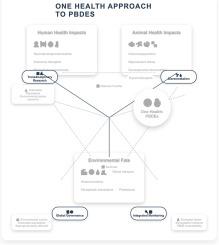A One Health approach to polybrominated diphenyl ethers (PBDEs): Integrating human, animal, and environmental health perspectives
IF 8.1
2区 环境科学与生态学
Q1 ENVIRONMENTAL SCIENCES
引用次数: 0
Abstract
Polybrominated diphenyl ethers (PBDEs) are persistent organic pollutants (POPs) used as flame retardants that pose interlinked environmental health challenges, making them an ideal focus for One Health assessment. This review synthesizes current scientific knowledge on PBDEs contamination based on a literature analysis of PubMed, Web of Science, Scopus, and Google Scholar databases. It examines shared contamination sources, exposure pathways, toxicological mechanisms, and intervention strategies. PBDEs exemplify the One Health paradigm through their ubiquitous anthropogenic sources, causing global environmental contamination across all health domains. Common exposure pathways (dietary intake, dust inhalation, and maternal transfer), create direct interface between human and wildlife health via contaminated environmental reservoirs. Across species, PBDEs have been linked to convergent toxicological outcomes, including endocrine disruption, neurodevelopmental deficits, reproductive impairments, and immunotoxicity, underscoring shared vulnerability patterns. Recent studies highlight the interaction between PBDEs and microplastics, which may enhance bioavailability and introduce novel exposure pathways. Vulnerable populations, notably children and pregnant women, face disproportionate risks requiring targeted interventions, including source control, advanced remediation technologies, and cross-sectoral surveillance systems. Despite regulatory progress, PBDEs remain a persistent global concern due to environmental persistence, continued emissions from legacy products, and emerging vectors such as microplastic-mediated transport. Addressing these challenges demands coordinated, cross-sectoral approaches that integrate environmental monitoring, transdisciplinary research, and harmonized regulatory frameworks. The One Health perspective offers a robust and holistic model for managing PBDEs and related POPs, emphasizing the urgency of collaborative solutions that recognize the intrinsic interconnectedness of human, animal, and ecosystem health in combating global contamination challenges.

多溴二苯醚的“同一个健康”方法:综合人类、动物和环境健康观点
多溴联苯醚(PBDEs)是用作阻燃剂的持久性有机污染物(POPs),构成相互关联的环境健康挑战,使其成为“同一个健康”评估的理想焦点。本综述基于PubMed、Web of Science、Scopus和谷歌Scholar数据库的文献分析,综合了目前关于多溴二苯醚污染的科学知识。它检查了共同的污染源、暴露途径、毒理学机制和干预策略。多溴二苯醚通过其无处不在的人为来源,在所有健康领域造成全球环境污染,从而体现了“同一个健康”范式。常见的接触途径(饮食摄入、粉尘吸入和母体转移)通过受污染的环境水库在人类和野生动物健康之间建立了直接的接口。在物种中,多溴二苯醚与趋同的毒理学结果有关,包括内分泌干扰、神经发育缺陷、生殖障碍和免疫毒性,强调了共同的脆弱性模式。最近的研究强调了多溴二苯醚和微塑料之间的相互作用,这可能会提高生物利用度并引入新的暴露途径。弱势群体,特别是儿童和孕妇,面临着不成比例的风险,需要有针对性的干预措施,包括源头控制、先进的补救技术和跨部门监测系统。尽管监管方面取得了进展,但由于环境的持久性、遗留产品的持续排放以及微塑料介导的运输等新媒介,多溴二苯醚仍然是全球持续关注的问题。应对这些挑战需要协调、跨部门的方法,将环境监测、跨学科研究和协调的监管框架结合起来。“同一个健康”观点为管理多溴二苯醚和相关持久性有机污染物提供了一个强有力的整体模型,强调了在应对全球污染挑战中认识到人类、动物和生态系统健康内在相互联系的协作解决方案的紧迫性。
本文章由计算机程序翻译,如有差异,请以英文原文为准。
求助全文
约1分钟内获得全文
求助全文
来源期刊

Chemosphere
环境科学-环境科学
CiteScore
15.80
自引率
8.00%
发文量
4975
审稿时长
3.4 months
期刊介绍:
Chemosphere, being an international multidisciplinary journal, is dedicated to publishing original communications and review articles on chemicals in the environment. The scope covers a wide range of topics, including the identification, quantification, behavior, fate, toxicology, treatment, and remediation of chemicals in the bio-, hydro-, litho-, and atmosphere, ensuring the broad dissemination of research in this field.
 求助内容:
求助内容: 应助结果提醒方式:
应助结果提醒方式:


